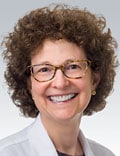Pediatric AD: Consider Adherence, Other Aspects of Treatment

ASHEVILLE, N.C. — Treating atopic dermatitis (AD) in most children — and working with parents — might be less dependent on the next, even better therapy than considering facets of poor response and dissatisfaction with treatment, according to a three-member expert panel mulling over strategies at the annual meeting of the Society for Pediatric Dermatology.

Dr Amy Paller
Despite a lengthy list of promising drugs for AD in late stages of clinical development, the “oldies but goodies,” remain a reasonable an appropriate initial approach in newly diagnosed infants and children with mild to moderate disease, according to Amy S. Paller, MD, chair of the dermatology department and professor of pediatrics and dermatology, Northwestern University, Chicago.
By oldies but goodies, Paller was referring to therapies like cyclosporine and methotrexate that remain the major form of treatment for AD in many countries — even if newer options often attract more attention in the United States.
Although Paller had just finished providing an update on the efficacy of new therapies, such as the interleukin-13 (IL-13) inhibitors tralokinumab (Adbry), which was approved by the FDA for treating AD in adults in December 2021, and lebrikizumab, which is thought likely to be soon approved in the United States on the basis of two recently published phase 3 trials, her remarks were triggered by comments from the audience during a subsequent panel discussion.
“Sure, parents ask about the systemic drugs even in young children, but I do not prescribe them [as first-line therapy in non-severe disease],” she said. She also agreed with an audience member, Stephen Gellis, MD, a pediatric dermatologist associated with Boston Children’s Hospital, that oldies but goodies should be tried first, resisting the pressure from parents to move too quickly to the latest and most expensive drugs.

Dr Peter Lio
Providing different perspectives, the two other panelists discussing the treatment of pediatric AD supported a go-slow approach before turning to the latest and most sophisticated therapies for AD. One strategy is to consider integrative medicine, according to Peter A. Lio, MD, director of the Chicago Integrative Eczema Center and clinical assistant professor of dermatology and pediatrics at Northwestern.
For parents not fully comfortable with standard pharmacologic agents, Lio said there is evidence to support some of the complementary approaches, and these can be reassuring to parents with an interest in alternative medicines.
In Western medicine, it is common to hear terms like “attack,” “kill,” and “suppress,” disease, but alternative therapies are generally coupled with terms like “restore,” “strengthen,” and “tonify,” he said.
“Who doesn’t want to be tonified,” he asked, noting that there are many sources of data suggesting that the number of patients seeking alternative medicine is “huge.” The alternative medicines are not generally taught in medical school and remain widely ignored in typical practice, but “our patients are interested even if we are not.”
Yet, there are data to support benefit from some of these alternative therapies, providing a win-win situation for patients who derive satisfaction from nontraditional therapies alone or combined with established pharmaceutical treatments.
Of these, Lio said there is support for the use of hempseed oil as a moisturizing agent and a strategy for improving barrier function in the skin of patients with AD. In a controlled crossover study , 2 teaspoons per day of dietary hempseed oil, a product that can be purchased in some grocery stores, was associated with significant reductions in skin dryness, itchiness, and use of topical medications relative to the same amount of olive oil, he noted.
Other examples include a compress made with black tea that was associated with an anti-inflammatory effect when followed by a moisturizer, in a published study. Although this was a trial in adults with facial dermatitis, Lio suggested that the same anti-inflammatory effect would be anticipated for other skin conditions, including AD in children.
As a third example, Lio said topical indigo, a traditional Chinese medicine used for a variety of dermatologic conditions, including psoriasis, has also demonstrated efficacy in a randomized trial compared with vehicle for mild to severe AD.
Complementary medicines are not for everyone, but they may have a role when managing the expectations of parents who are not fully satisfied or express concern about regimens limited to mainstream therapies alone, according Lio. In diseases that are not curable, such as AD, he thinks this is a strategy with potential for benefit and is reassuring to patients.
Another way to avoid moving to the most expensive drugs quickly is simply verifying that patients were compliant with the drugs that were used first, according to Steven R. Feldman, MD, PhD, professor of dermatology, Wake Forest University, Winston-Salem, North Carolina.

Dr Steven Feldman
This is old news, but Feldman strongly believes that failure to adhere to therapy is basically the fault of the physician, not the patient. He made an analogy to a successful piano teacher, who provides a child with sheet music and then sees the child once a week to track progress. He juxtaposed this piano teacher to one who gives the child sheet music and tells the child to come back in 10 weeks for the recital. It is not hard to guess which approach is more effective.
“Typically, doctors are worse than that second teacher,” he said. “Doctors are like a piano teacher that does not give you the sheet music but says ‘Here is a prescription for some sheet music. Take this prescription to the sheet music store. I have no idea how much it will cost or how you will pay for it. But once you fill this prescription for sheet music, I want you to practice this every day,’ ” he said, noting that the prescription is typically accompanied with warning about the potential for side effects, such as rashes, diarrhea, or infection.
When the patient next comes in 10-12 weeks later and is not better, “the doctor says I will give you a harder piece of sheet music and maybe two or three other instruments to practice at the same time,” said Feldman, expressing why compliance is such a struggle.
This might explain why patients with AD do not immediately respond to the oldies but goodies and resort to the more expensive therapies they might not need, Feldman implied, reiterating the theme that emerged from the AD panel: Better and more options are needed for AD of the most severe types, but better management, not better drugs, is typically what is needed for most patients.
Feldman, Lio, and Paller have financial relationships with more than 30 pharmaceutical and cosmetic companies, some of which manufacture therapies for atopic dermatitis.
Society for Pediatric Dermatology 2023 annual meeting. Presented July 14, 2023.
Source: Read Full Article